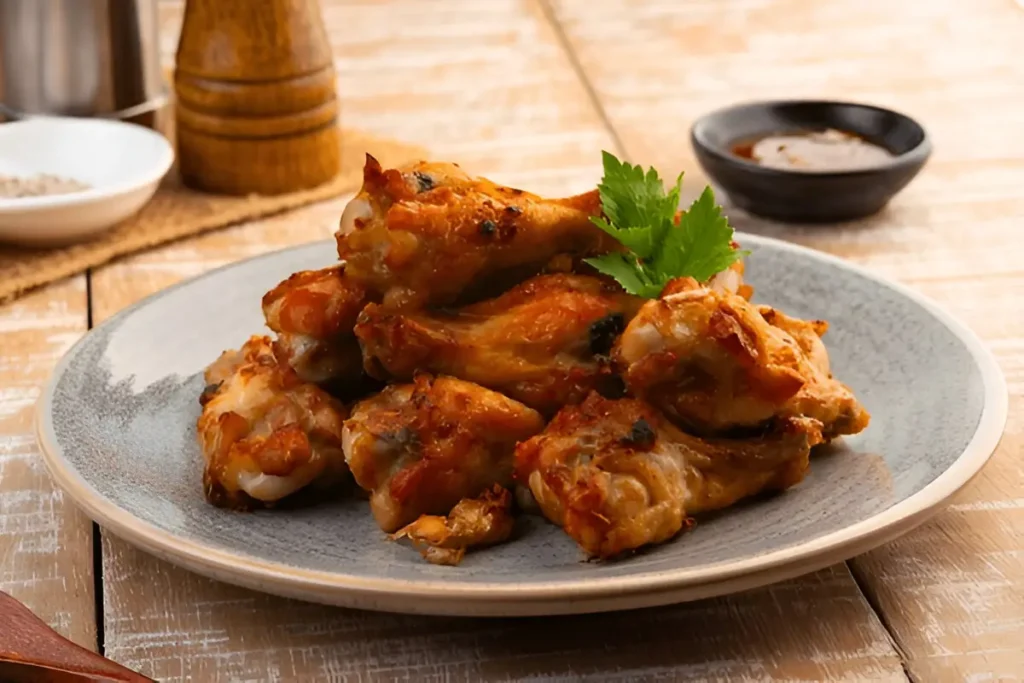Chicken drumsticks are a favorite for many, whether at a backyard BBQ or a family dinner. They’re easy to eat, especially for kids, and they often pack a lot of flavor. Beyond just being tasty, though, what exactly are we getting from a nutritional standpoint when we enjoy these popular chicken pieces? Let’s break down the Chicken Drumstick Nutrition: Key Information you need to know.
Table of Contents
Understanding Chicken Drumstick Nutrition: A Closer Look
Chicken drumsticks are a popular choice for many home cooks, and for good reason. They’re flavorful, affordable, and incredibly versatile. But what exactly are you getting nutritionally when you bite into one? Understanding the nutritional profile of drumsticks is key to incorporating them into a balanced diet. Many people wonder, “Is a chicken drumstick healthy?” The answer really depends on how it’s prepared and what else you’re eating. They are a good source of protein, which is vital for muscle repair and growth. You might also be curious about “Is drumstick high in protein?” Yes, they definitely contribute a good amount of protein to your meal. However, they also come with a notable amount of fat, leading to the question, “Do drumsticks have a lot of fat?” Drumsticks do contain more fat than leaner cuts like chicken breast, but this fat contributes to their flavor and moisture. It’s important to consider both the saturated and unsaturated fats present. While they are a good source of protein, it’s also worth noting that “How many drumsticks can I eat a day?” is a question best answered by considering your overall daily caloric and macronutrient needs. A typical serving of a drumstick, especially with the skin on, can contribute a significant number of calories. For example, a single serving of Pollo Campero grilled chicken thigh & drumstick has 340 calories, with a breakdown of 2% carbohydrates, 63% fat, and 35% protein. This highlights the importance of portion control and preparation methods when aiming for a healthy meal. We’ll explore these aspects further in the following sections.
Key Nutritional Components of Chicken Drumsticks
Chicken drumsticks are a popular choice for many reasons, and understanding their nutritional makeup is key to appreciating them. They’re a fantastic source of protein, which is vital for building and repairing tissues. So, how much protein is in 2 chicken drumsticks? Generally, you can expect around 12-14 grams of protein per drumstick, depending on the size and whether the skin is on or off. This makes them a solid contributor to your daily protein intake.
When we talk about fat content, drumsticks do contain fat, but it’s a mix of both saturated and unsaturated fats. The skin is where most of the fat resides, so if you’re watching your fat intake, removing the skin before eating can make a difference. For example, a fried chicken drumstick from Kwik Trip, with skin, contains about 6g of total fat, with 1.5g being saturated fat. This contributes 8% to the daily value for total fat and saturated fat, according to their nutritional information. It’s good to be aware of these details.
As for carbohydrates and calories, drumsticks are naturally low in carbs. The calories come primarily from the protein and fat. A typical baked drumstick without skin might hover around 150-170 calories, but frying or adding sauces can increase this number significantly. It’s all about how you prepare them.
Beyond the macronutrients, drumsticks also offer a good range of vitamins and minerals. They are a good source of B vitamins, particularly B6 and niacin, which help with energy metabolism. You’ll also find minerals like phosphorus, important for bone health, and selenium, an antioxidant. These micronutrients play a big role in keeping our bodies functioning well.
Protein Powerhouse
Chicken drumsticks are a great way to get your protein. Protein is essential for muscle growth, repair, and overall body function. Eating drumsticks can help you feel full and satisfied after a meal.
Fat Content: Saturated vs. Unsaturated
Drumsticks contain both types of fat. The skin is the main source of fat. If you’re mindful of your fat intake, consider enjoying them without the skin. This simple step can help manage the amount of fat you consume.
Carbohydrates and Calories
These tasty pieces of chicken are naturally low in carbohydrates. The calories you get are mainly from the protein and fat content. Preparation methods greatly influence the final calorie count.
Vitamins and Minerals Found in Drumsticks
Drumsticks aren’t just about protein and fat; they also provide important vitamins and minerals. You’ll find B vitamins like niacin and B6, which are important for energy. They also offer minerals such as phosphorus and selenium, contributing to bone health and acting as antioxidants.
The Impact of Cooking Methods on Drumstick Nutrition

How you cook your chicken drumsticks can really change what you get out of them nutritionally. It’s not just about taste; the method matters for fat content, moisture, and even how well your body can use the protein. Let’s break down some common ways to prepare them.
Baked vs. Fried Drumsticks
When you bake drumsticks, especially without adding extra fat, you’re generally keeping the fat content lower. The heat cooks the chicken through, and if you leave the skin on, it can get nicely browned and a little crispy. This method is pretty straightforward and doesn’t add many calories beyond what’s naturally in the chicken.
Deep frying, on the other hand, is a different story. The chicken is submerged in hot oil, which makes the outside incredibly crispy. However, this process means the drumstick absorbs a good amount of that oil. This significantly increases the overall fat and calorie count. While delicious, it’s definitely a more indulgent option compared to baking. Think of it as a treat rather than an everyday meal if you’re watching your intake.
| Cooking Method | Approx. Fat (g) | Approx. Calories |
|---|---|---|
| Baked (skin on) | 15 | 210 |
| Deep Fried (skin on) | 25 | 300 |
Note: These are approximate values and can vary based on oil absorption and specific preparation.
Grilled Drumsticks: A Healthier Option?
Grilling drumsticks is often seen as a healthier choice, and for good reason. The direct heat from the grill can help some of the fat drip away as the chicken cooks. Plus, if you’re marinating them, the flavors really soak in. Grilling can give you that nice smoky char without needing a lot of added oil. It’s a great way to get a flavorful meal that’s often lighter than fried versions.
When grilling, using a marinade can add flavor and help keep the chicken moist. Just be mindful of sugary marinades, as they can burn easily over the direct heat of the grill.
Other methods like slow cooking or using an air fryer also have their own nutritional profiles. Slow cooking breaks down connective tissues, making the meat tender and allowing flavors to meld, but it doesn’t typically add fat. Air frying mimics the crispiness of deep frying with much less oil, making it a popular healthier alternative for achieving that satisfying crunch.
Ultimately, the cooking method you choose can significantly alter the nutritional makeup of your chicken drumstick. For a lighter meal, baking, grilling, or air frying are generally better bets than deep frying. Remember, the skin itself also contains a good amount of fat, so removing it before or after cooking can further reduce the fat content if that’s a goal.
Cooking methods significantly impact Maillard reactions, influencing food color and water retention. Protein digestibility is enhanced through bromelain hydrolysis and controlled processing techniques.
Comparing Chicken Drumsticks to Other Chicken Cuts
When you’re thinking about chicken for dinner, it’s easy to just grab whatever’s on sale. But have you ever stopped to really compare the different parts of the chicken? Drumsticks are super popular, and for good reason. They’re usually pretty affordable, and let’s be honest, they’re just plain tasty. But how do they stack up against other cuts like chicken breasts or thighs?
Drumsticks vs. Chicken Breasts
Chicken breasts are often seen as the go-to for health-conscious eaters. They’re lean, meaning they have less fat, especially saturated fat, compared to drumsticks. This makes them a favorite for those watching their calorie intake or trying to cut down on fat. However, this leanness can also mean they dry out more easily if you’re not careful with cooking. Drumsticks, with their bone and skin, tend to stay moister and have a richer flavor, partly due to their higher fat content. If you’re looking for a quick, lean protein source, breasts are great. If you prefer a bit more flavor and moisture, and don’t mind a little extra fat, drumsticks are a solid choice.
Drumsticks vs. Chicken Thighs
Chicken thighs are kind of in the middle ground between breasts and drumsticks. They have a good amount of fat, which keeps them moist and flavorful, similar to drumsticks. They also have a bit more dark meat than breasts. When it comes to cooking, thighs are pretty forgiving – they’re hard to overcook. Drumsticks, being smaller and on the bone, cook a bit faster and offer that classic, easy-to-eat shape. Both are great for flavor, but thighs might offer a slightly more tender bite for some people. It really comes down to personal preference and what you’re making.
Nutritional Snapshot Comparison
Let’s break down some general numbers for a 3.5-ounce serving (about 100 grams) of cooked chicken, skinless:
| Cut | Calories | Protein (g) | Fat (g) | Saturated Fat (g) |
|---|---|---|---|---|
| Drumstick | ~200 | ~20 | ~12 | ~3.5 |
| Chicken Breast | ~165 | ~31 | ~3.6 | ~1 |
| Chicken Thigh | ~210 | ~24 | ~13 | ~4 |
Note: These are approximate values and can vary based on cooking methods and whether the skin is included.
As you can see, drumsticks and thighs are pretty similar in terms of calories and fat, with breasts being the leaner option. But don’t forget, the skin on drumsticks adds extra fat and calories, but also a lot of flavor and crispiness when cooked right. It’s all about balance and what you’re aiming for in your meal. For many, the flavor payoff from a well-cooked drumstick makes it a winner, especially when you consider their affordability and how well they take to marinades and spices, like those found in traditional Indian curries.
Incorporating Chicken Drumsticks into a Balanced Diet

So, how do you fit these tasty drumsticks into your regular meals without going overboard? It’s actually pretty straightforward. Think of them as a versatile protein source that can be adapted to many different eating styles. For instance, if you’re watching your intake, baking or grilling them with minimal added fat is the way to go. This keeps the protein high while managing the fat content.
Is chicken drumstick good for bodybuilding? Absolutely, especially when prepared smartly. The protein is key for muscle repair and growth. Just be mindful of how you cook them and what you pair them with. A drumstick alongside some steamed veggies and a complex carb like brown rice makes for a solid post-workout meal.
Here are a few ideas for incorporating them:
- Leaner Preparations: Opt for baking, grilling, or air-frying instead of deep-frying. This significantly cuts down on added fats.
- Portion Control: While delicious, be aware of serving sizes, especially if you’re tracking calories or macros.
- Flavorful Pairings: Combine drumsticks with a variety of vegetables and whole grains for a balanced plate. Think roasted root vegetables, a fresh salad, or quinoa.
- Marinades and Rubs: Experiment with herbs, spices, garlic, and citrus for flavor instead of relying on heavy sauces or excessive salt.
Remember, the way you prepare your drumsticks plays a huge role in their overall nutritional profile. Simple seasonings and healthier cooking methods can make them a great addition to almost any diet.
When you’re looking for a protein-rich meal, these heart-healthy spicy chicken drumsticks are a fantastic option. They pack a good amount of protein and can be seasoned to your liking without relying on excess salt.
Conclusion: The Nutritional Value of Chicken Drumsticks
So, what’s the final word on chicken drumsticks? They really are a pretty solid choice when you’re thinking about what to put on your plate. They’re packed with protein, which is great for keeping you full and helping your body repair itself. Plus, they offer a good amount of important vitamins and minerals that your body needs to work right.
Protein Powerhouse
Drumsticks are a fantastic source of lean protein. This protein is vital for building and repairing tissues, making enzymes, and supporting your immune system. It’s what helps you feel satisfied after a meal, too.
Fat Content: Saturated vs. Unsaturated
Now, about the fat. Drumsticks do have more fat than, say, chicken breast, especially if you eat the skin. Most of this fat is unsaturated, which is the kind your body actually needs. However, there is some saturated fat in there, so if you’re watching your intake, you might want to consider removing the skin before eating.
Carbohydrates and Calories
Chicken drumsticks don’t really have any carbohydrates. Their calories come mainly from the protein and fat content. A typical cooked drumstick, without the skin, is around 150-200 calories, making them a reasonable part of a balanced diet.
Vitamins and Minerals Found in Drumsticks
Beyond protein and fat, drumsticks bring other good stuff to the table. They’re a good source of B vitamins, like niacin and B6, which help your body turn food into energy. You’ll also find minerals like phosphorus, important for bone health, and selenium, an antioxidant that helps protect your cells. Chicken is a rich source of essential nutrients like B vitamins, phosphorus, and selenium. These nutrients play a role in energy production, maintaining bone health, and supporting immune function. Chicken nutrients.
The Impact of Cooking Methods on Drumstick Nutrition
How you cook them really changes the nutritional picture. Baking or grilling drumsticks with minimal added fat is a healthier route. Frying, especially deep-frying, adds a lot of extra fat and calories. Even air frying can give you that crispy texture with less oil than traditional frying.
Comparing Chicken Drumsticks to Other Chicken Cuts
Compared to chicken breasts, drumsticks are generally higher in fat and calories but also often more flavorful and moist. They’re usually more budget-friendly too. If you’re looking for the leanest option, breast meat is the way to go, but drumsticks offer a satisfying and tasty alternative.
Incorporating Chicken Drumsticks into a Balanced Diet
Adding drumsticks to your meals can be easy. Pair them with plenty of vegetables and whole grains for a complete meal. Think roasted drumsticks with a side of broccoli and quinoa, or grilled drumsticks with a fresh salad. They’re versatile enough to fit into many different meal plans.
Ultimately, chicken drumsticks are a flavorful and accessible source of protein and other nutrients. Enjoying them as part of a varied diet, with attention to cooking methods, can be a delicious way to meet your nutritional needs.
So, What’s the Verdict?
From backyard barbecues to fancy dinners, chicken drumsticks really do it all. They’re easy on the wallet, a hit with pretty much everyone, and can be cooked up in so many different ways. Whether you’re going for spicy, sweet, or something in between, there’s a drumstick recipe out there for you. So next time you’re wondering what to make for dinner, don’t forget about these humble but mighty chicken pieces. They’re a simple way to bring some deliciousness to your table.
Frequently Asked Questions
What are the main health benefits of eating chicken drumsticks?
Chicken drumsticks are a great source of protein, which is important for building and repairing muscles. They also contain essential vitamins and minerals like B vitamins, phosphorus, and zinc, which help your body function properly.
How does cooking method affect the nutrition of chicken drumsticks?
The nutritional content of drumsticks can change depending on how you cook them. Baking, grilling, or air-frying are generally healthier choices than deep-frying, as they use less oil and can reduce the amount of unhealthy fats.
Are chicken drumsticks high in fat?
While drumsticks do contain some fat, much of it is located under the skin. Removing the skin before or after cooking can significantly lower the fat content. They are also a good source of lean protein.
What vitamins and minerals are found in chicken drumsticks?
Yes, drumsticks are a good source of B vitamins, such as niacin and B12, which are vital for energy production and brain health. They also provide minerals like phosphorus and selenium, which support bone health and the immune system.
How do chicken drumsticks compare to chicken breasts nutritionally?
Compared to chicken breasts, drumsticks generally have a bit more fat and calories due to their natural marbling and the presence of dark meat. However, they also offer a richer flavor and are often more budget-friendly.
How can I include chicken drumsticks in a healthy diet?
You can enjoy drumsticks as part of a balanced diet by pairing them with plenty of vegetables, whole grains, and other lean protein sources. Opting for healthier cooking methods like baking or grilling also makes them a nutritious choice.



